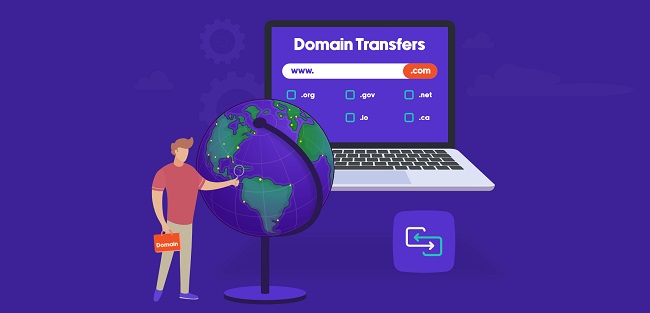If you’ve recently purchased a new domain or are looking to switch to a different registrar, you may be wondering how long do domain transfers take to be completed. Domain transfers can be a mystery to those who have yet to go through the process, but with some knowledge, you can ensure a smooth and timely transfer. In this blog post, we’ll discuss the factors that can impact the time it takes to transfer a domain and provide some tips for minimizing any potential downtime during the transfer process. So, if you’re curious about how long do domain transfers take, keep reading!
What Is A Domain Transfer?
A domain transfer is transferring a domain name from one registrar to another. This is done for various reasons, such as a desire to have multiple domains managed in one place or because a new registrar offers better services than the old one. It’s important to note that the domain itself doesn’t actually move – instead, it’s just the registration that changes hands. When you transfer a domain, the ownership, contact information, and other associated details remain the same.
The actual process of transferring a domain typically starts with obtaining an authorization code from your current registrar. You then provide this code along with other required information to your new registrar, who will initiate the transfer and submit your request to the registry – usually ICANN or Verisign depending on the domain being transferred.
Once the registry receives your request, they will review it and then complete the transfer if everything checks out. How long this takes depend on several factors (which we’ll discuss below). Generally speaking though, a typical domain transfer can take anywhere from five days to two weeks – though it can be faster or slower depending on the situation.
How Long Do Domain Transfers Take?

Domain transfers typically take anywhere from a few hours to several days to complete, depending on a variety of factors. The exact time frame for a domain transfer can vary depending on the domain registrar and hosting provider involved in the process, as well as the complexity of the domain transfer itself.
Generally speaking, domain transfers can take longer if there are issues with the domain’s configuration, such as incorrect contact information or incomplete DNS settings. In some cases, domain transfers can also be delayed by administrative or technical issues at the registrar or hosting provider.
To ensure a smooth and timely domain transfer, it’s important to follow all of the necessary steps and requirements outlined by the registrar and hosting provider. This may include verifying your contact information, unlocking the domain, obtaining an authorization code, and updating your DNS settings.
If you have any questions or concerns about the domain transfer process, it’s best to contact your registrar or hosting provider for assistance. They can provide you with more information about the specific requirements and time frame for your domain transfer, and help you troubleshoot any issues that may arise.
Steps to ensure a smooth and timely domain transfer:
Verifying Your Contact Information
Verifying your contact information is an important step in the domain transfer process, as it ensures that the new registrar can contact you regarding the transfer. It’s essential to ensure that all your contact information is accurate and up-to-date, including your name, address, phone number, and email address. You can typically update this information through your domain registrar’s account management panel. It’s important to note that the domain transfer may be delayed or even canceled if your contact information is incorrect or outdated. Additionally, if your domain has enabled privacy protection, you’ll need to disable it temporarily to transfer it.
Unlocking the Domain
When a domain is registered, it is often “locked” to prevent unauthorized transfers. To transfer your domain, you’ll need to unlock it first. This can be done through your domain registrar’s account management panel. However, it’s important to note that some registrars may have different processes for unlocking domains. For example, some registrars may require you to contact their support team to unlock your domain. It’s also important to ensure the domain is eligible for transfer before unlocking it, as some domain extensions (such as newly registered or recently transferred domains) may have transfer restrictions.
Obtaining an Authorization Code
An authorization code (also known as an EPP code or transfer code) is a unique code that is required to initiate a domain transfer. You’ll need to obtain this code from your current registrar before transferring your domain to a new registrar. The process for obtaining an authorization code may vary depending on the registrar, but it typically involves logging into your account and requesting the code. Some registrars may require you to verify your identity or the domain’s ownership before providing the authorization code. It’s important to note that authorization codes are typically only valid for a limited time, so you’ll need to initiate the transfer process immediately after obtaining the code.
Updating Your DNS Settings
DNS (Domain Name System) settings direct traffic to your website. When transferring your domain to a new registrar, you must update your DNS settings to ensure your website remains accessible. This typically involves updating the nameservers associated with your domain. Updating your DNS settings may vary depending on your hosting provider, but it typically involves logging into your hosting account and updating the nameserver information.
It’s important to note that changes to DNS settings can take up to 48 hours to propagate, so you may need to wait for this process to complete before your website is fully accessible through the new registrar. Additionally, if you have an email associated with your domain, you may need to update your email settings to ensure that you can continue to send and receive emails after the transfer.
Why Do Domain Transfers Take So Long?

Domain transfers are a common task for website owners who want to move their websites from one domain registrar to another. However, the process of transferring a domain can be complex and time-consuming. In this response, we’ll explore some of the reasons why domain transfers can take longer than expected.
Authorization Process
Before a domain can be transferred, the current domain owner must authorize the transfer. This process can take time as the current owner may need to approve the transfer request, confirm their contact information, or take other steps to ensure the transfer is legitimate. Depending on the current registrar’s policies, this process can take anywhere from a few hours to several days.
Domain Registrar Policies
Different domain registrars may have different policies and procedures for handling domain transfers. Some registrars may require additional verification steps, while others may have different timelines for processing transfer requests. It’s important to understand the policies of both the current and new registrars to ensure a smooth transfer process.
Domain Status
If the domain is locked, expired, or has any other issues, this can delay the transfer process until the issues are resolved. For example, if the domain is in a redemption period after expiration, restoring the domain and initiating the transfer process may take several days or weeks.
Time to Propagate
After a domain transfer is completed, the new domain information can take up to 24-48 hours to propagate throughout the internet. During this time, the website and email associated with the domain may experience temporary downtime. This delay is caused by the time it takes for DNS (Domain Name System) servers worldwide to update their records to reflect the new domain information.
Administrative or Technical Errors
Sometimes, errors can occur during the transfer process, which can cause delays. For example, a domain name or contact information typo can cause the transfer request to be rejected or delayed. It’s important to double-check all details and contact information to ensure that the transfer process goes smoothly.
Factors That Can Affect the Length of a Domain Transfer
Domain transfer can be a time-consuming process, especially if you are not aware of the factors that can affect the duration of the transfer. There are several factors that can cause delays in transferring a domain, ranging from the domain registrar’s policies to the domain age and administrative contact information. In this response, we will discuss some factors that can affect the length of a domain transfer and briefly explain each point.
1. Domain Registrar Policies
Different domain registrars have different policies and procedures for transferring domains. Some registrars have strict policies that require additional verification or processing time, which can delay the transfer. It’s essential to research the registrar’s policies before initiating a transfer to ensure that you comply with their requirements. Additionally, some registrars may charge a fee for domain transfers, which can also affect the cost of transferring a domain.
2. Domain Ownership Verification
Before a domain can be transferred, the new registrar will need to verify that the person or organization requesting the transfer is the rightful owner of the domain. This process involves verifying the domain’s contact information and may require additional documentation, such as a government-issued ID or business license. Delays can occur if there are discrepancies in the information provided or if the previous registrar needs to respond to verification requests.
3. Domain Age
The age of a domain can also affect the length of a transfer. Older domains that have been active for a long time may have more complex transfer requirements or require additional verification steps, slowing down the transfer process. Additionally, some TLDs require a domain to be active for a specific period before a transfer can take place. For example, some TLDs require a domain to be active for 60 days before it can be transferred.
4. Domain Extension
Different top-level domains (TLDs) may have specific transfer policies or requirements that must be met before a transfer can take place. For example, some TLDs require additional verification steps or charge a fee for transferring a domain. Additionally, some TLDs may have specific requirements for updating the domain’s contact information or nameservers, which can also affect the transfer process.
5. Administrative Contact Information
The administrative contact information associated with the domain plays a critical role in transferring a domain name. If the information is outdated or incorrect, it can cause delays in the transfer process. The new registrar may need to contact the administrative contact to verify ownership or update contact information before the transfer can proceed. It’s essential to ensure that the administrative contact information is up to date before initiating a transfer to avoid any delays.
6. Time of Year
The time of year can also impact the length of a domain transfer. During busy periods, such as holidays, there may be more requests for transfers, which can cause delays in processing times. It’s important to consider the time of year when planning a domain transfer and allow for additional time during busy periods.
Understanding the factors that affect the length of a domain transfer helps you prepare for any potential delays and ensure a smooth transfer process. By being patient and allowing ample time for the transfer, you can avoid unnecessary stress and ensure that the transfer is successful.
How to Speed Up the Domain Transfer Process

The domain transfer process involves transferring domain name ownership from one registrar to another. The process can take anywhere from a few hours to several days, depending on a variety of factors. Here are some tips to help speed up the domain transfer process:
- Check domain transfer requirements: Before initiating the transfer process, make sure you have met all the transfer requirements for your domain registrar. These requirements may include unlocking your domain, disabling WHOIS privacy, and obtaining the domain transfer authorization code.
- Choose a reliable registrar: Choose a reliable and efficient registrar that can handle your domain transfer quickly and securely. Research the registrar’s reputation and customer reviews to ensure that they have a good track record for speedy transfers.
- Plan ahead: Start the domain transfer process well in advance of any important deadlines, such as the expiration date of your domain or the launch of a new website. Transfers can take up to several days to complete, so it’s best to give yourself plenty of time.
- Double-check all information: Double-check all the information you provide during the transfer process, including your contact information, the domain name, and the transfer authorization code. Errors or inconsistencies can slow down the process and may result in the transfer being rejected.
- Respond quickly to emails: Keep an eye out for emails from your current registrar and your new registrar. Respond promptly to any requests for information or confirmation to keep the transfer process moving forward.
- Contact support: If you encounter any issues during the transfer process, contact customer support for your current and new registrar. They can help you troubleshoot any issues and keep the transfer moving forward.
The key to speeding up the domain transfer process is to be proactive, thorough, and responsive throughout the entire process.
FAQs
Do I need to do anything to speed up the domain transfer process?
The best way to speed up the domain transfer process is to ensure that all of the information you provide is accurate and up-to-date, including your contact information and the information for your new registrar. Additionally, be sure to follow all of the necessary steps and procedures outlined by your current and new registrars.
Can I cancel a domain transfer if it’s taking too long?
Yes, you can cancel a domain transfer if it’s taking too long or if you no longer want to transfer your domain. However, it’s important to note that some registrars may charge a fee for canceling a transfer.
Will my website be down during the domain transfer process?
Your website may experience some downtime during the domain transfer process, but the length of the downtime will depend on a number of factors, such as the speed of the transfer and the settings of your website. To minimize downtime, you can work with your current and new registrars to ensure a smooth transfer process.
Can I transfer a domain that is about to expire?
Transferring a domain that is about to expire is not recommended. This is because the transfer process can take several days to complete. If the domain expires during the transfer, it may become unavailable or go into a redemption period, which can be more expensive to recover.
How can I speed up my domain transfer?
To ensure a smooth domain transfer process, do your research and choose a reputable registrar, follow all of the steps and procedures outlined by your current and new registrars, and keep accurate and up-to-date contact information. Additionally, be prepared to address any issues or delays that may arise during the transfer process.
Final Words
Domain transfers are an important process that can be time-consuming. The exact length of time it will take to transfer a domain depends on various factors, such as the registrar and the type of domain being transferred. However, there are specific steps you can take to speed up the process, such as getting all the required information in advance and contacting your new and current registrars for help. With a bit of effort and planning, you can complete the domain transfer quickly and smoothly.

